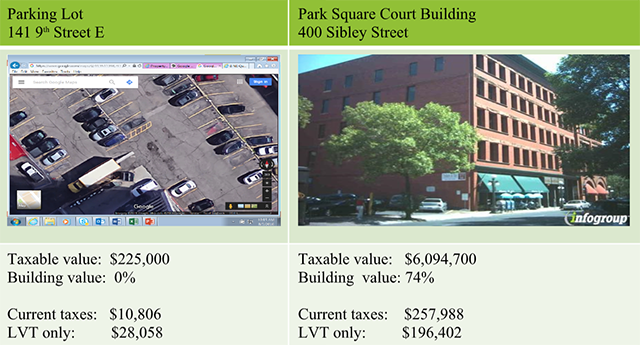Our colleagues in Minneapolis are proposing legislation authorizing a targeted version of LVT. How about those incentives! Read more…
Land Value Tax: A promising land-use tool proposed for our communities
By Alex Burns and Rich Nymoen
February 10, 2020 09:00 am
Creating sustainable land use involves more than just planning. It also requires incentives. That’s why the North Star Chapter of the Sierra Club has joined with the Minnesota chapter of Common Ground USA to support state legislation that allows towns to create Land Value Tax (LVT) Districts.
The current property tax system taxes the total value of properties. This includes both the land and any structures on top of it. Because the average property has most of its value in the building, the conventional property tax is mostly a tax on building value.
This creates perverse incentives for speculators to buy up vacant and underused sites and to avoid building intensive uses. For the speculator, as long as annual holding costs are lower than the site’s annual appreciation in value, it pays to hold out. For those who want to make the most of the site, the more building value they create, the more they pay in property taxes.
As a result, a significant portion of land in cities, particularly near downtown areas, remains locked up as surface parking lots or other low-intensity uses. This has big environmental implications. Dense, high-intensity land use promotes sustainable transportation habits by making it easier to walk, bike, and take transit. It also limits urban sprawl and the resulting loss of habitat by concentrating development in existing urbanized areas.
LVT Districts would flip the script and tax the land value portion of properties at a higher rate than the building value portion. Places that have done this have experienced tremendous in-fill and redevelopment effects, along with other benefits. In the U.S., Pennsylvania has used this approach the most.
After Harrisburg, once one of the most distressed cities in the nation, adopted this approach in 1975, it saw 5,200 vacant properties restored and taxable businesses rise from 1,908 to 5,900. A number of smaller Pennsylvania towns saw dramatic increases in building permits issued and a majority of residents received tax reductions under the reform. A widely cited study of LVT use in Pittsburgh showed that building construction there leapt ahead of other Rust Belt cities.
The bill we’re supporting enables cities to pass ordinances that, first, identify specific geographic areas or parcels that would be in an LVT district. The district could be citywide or for just a corridor or neighborhood.
Once a district is designated, officials can then calculate its revenue under the conventional property tax system and then set out how to maintain the same level of revenue under a land value tax system.
The example below shows the effects on two properties if the NE Quadrant of downtown St. Paul were placed in such a district. The parking lot’s taxes almost triple, which creates development pressure to put it better use, and the Park Square Court Building’s taxes decrease by 24%, rewarding a land use that contributes to its surroundings.

Courtesy of the authors
Although this reform proposal has been around for a long time and is most associated with Gilded Age reformer Henry George, there has been a recent chorus of voices from the fields of planning, architecture, and economics calling for its widespread adoption. It’s time for Minnesota communities to have this tool at their disposal.
Alex Burns is land use and transportation chair of the Sierra Club North Star Chapter. Rich Nymoen is the president of Common Ground USA Minnesota Chapter.


